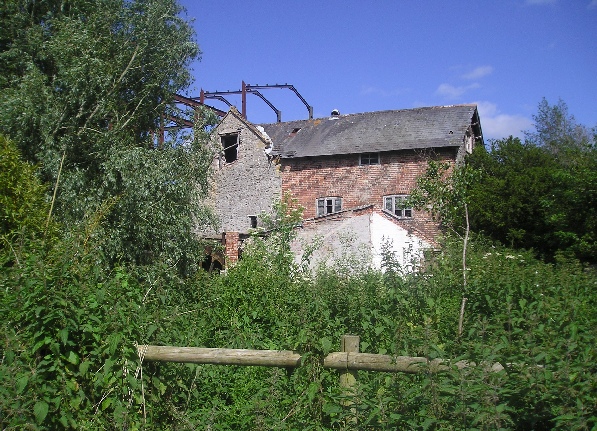WESTFORD MILL
In 1999 the death of David Fowler forced the sale of Westford Mill, the last working
mill in the Axe Valley. This article was written in 2000, shortly after the Mill
came on to the market. It is now being r enovated for use as a private residence.
enovated for use as a private residence.
Prior to the Industrial Revolution – in which the widespread use of evolving steam
power played a major part – the bulk of rural industrial plants were driven either
by wind or water. Thus in this area, the reliable annual flow of the Axe was used
at a number of places for milling and, in Thorncombe parish, even tributaries like
the Synderford and the humble Stonelake were exploited, in their cases by the cloth-making
mills at Shedrick and Chaffeigh.
Cloth-making in the West Country was effectively snuffed by mass production in
the modernised mills that were flourishing in the north in the 19th century leading
to the rapid decline of cloth-making in this area and to the disappearance of the
associated mills. Corn mills on the other hand, continued to operate, including at
least four on the Axe, until comparatively recently. Since 1991, the only working
mill was Fowlers at Westford. It was therefore, a particularly sad occasion when
this surviving outpost of parish industry ceased production at the end of March 2000.
Known originally as Paul’s Mill, the property was brought by great grandfather
Fowler, a baker, for his son H T Fowler in 1879 and ended its days as Fowler Brothers
– run by great grandsons John (who died in 1999) and David. The mill was originally
a gristing mill for locally grown barley and wheat. In 1888 flour – stoneground by
waterpower – was added to the mill’s output. The history of the use of waterpower
in Westford is believed to date back to the 15th or 17th century with a butter wheel
at Westford Farm. When milling started, new premises were built on the present site
including a substantial dwelling house, the deeds for which date from 1721. By 1926
demand had increased sufficiently to require a gas engine to supplement water power
from the Axe. At this time up to 15 men were employed at the mill, where output had
increased steadily after 1918 and reached a peak of 140-180 tons weekly during the
1970s and 1980s.
By 1950, village bakeries were closing, reducing the call for flour. In its place
the demand for feed for cattle increased and in the early 1960s electrical machinery
was introduced to cube and pellet cattle and other animal feeds. Apart from locally
produced cereals, these feeds required maize-gluten, sunflower, soya and rape. Mainly
imported by sea via Bristol or Teignmouth, they were delivered to Chard Junction
by rail, packed in 2½ cwt sacks and man handled on to lorries for onward conveyance
to the mill. (NB current regulations limit sack weights to 25 kilos - ½ cwt!!)
With the bulk of customers being either farms or families with livestock, house-to-house
delivery was always an important facet of the business. A driver, horse and cart
would spend a whole day delivering bags of feed to household in the Tatworth area.
This process was expedited in 1920 by the purchase of a Napier 2 ton lorry, replaced
in due course by a Thorneycroft. As the domestic keeping of pigs and poultry declined,
the bulk of the Mill’s business switched to family farms. To cope with the large
deliveries an Albion Chieftain 7 tonnes was purchased in 1955 and gave good service
for 15 years.
Early in the 1970s, the Fowler brothers decided to diversify and planted around
400 cobnut trees on part of the land that was originally Westford Farm. Part of the
remaining plantation is pictured above. Hitherto cobnuts had been something of a
Kentish speciality (as they still are today), the greensand in part of the Weald
of Kent being particularly conducive to their culture. Perhaps due to the presence
of greensand at Westford, the trees there also flourished and the plantation eventually
grew to 1400 trees, the crop from which amounted to a tenth of the UK total. The
nuts were gathered in September and the picking became an annual event for the local
family parties who participated. The main outlet was Bristol Market whence the nuts
disappeared into the green grocery and confectionary trades. In recent years the
demand at Bristol has declined and this has coincided with difficulty in securing
sufficient pickers at Westford.
As we are all aware, family farms of modest acreage that for years have been the
mainstay of west country farming, are also experiencing viability problems. Whilst
the outlook for small mills like Westford is thus not good, the death of John Fowler
in 1999 forced the family to consider the closure of the business; continuation would
have involved major expenditure on plant renewal and this factor together with the
malaise in farming and the growing burden of bureaucratic paperwork brought about
the decision to close. The whole complex including the nut orchard was subsequently
offered for sale as an industrial site.
Warm thanks are due to Mr David Fowler without whose cooperation this article could
not have been written.
PETER MORELAND
First published in the TVT News, winter 2000. Reproduced by kind permission of Mrs
Sheila Moreland.




enovated for use as a private residence.